If you find this manual useful,
how about a donation of
$3 to:
M. Butkus, 29 Lake Ave.,
High Bridge, NJ 08829-1701
and send your e-mail
address
so I can thank you.
Most other places would charge
you $7.50 for
a electronic copy
or $18.00 for a hard to read Xerox copy.
This will help me to continue to host this site,
buy new manuals, and pay their shipping costs.
It'll make you feel better, won't it ?
If you use Pay Pal, use the link below.
Use the above address for a check, M.O. or cash.
RIGHT CLICK ON LINK BELOW,
CHOOSE "SAVE TARGET AS"
SAVE TO FOLDER OF YOUR CHOICE
Problems
opening PDF files or printing problems
- click here
Chinon Genesis GS-7 PDF
Chinon Genesis GS-7 Mode D'Emploi
- direct
from manual -
Chinon Genesis GS-7 Bedienungsanleitung
Chinon Genesis GS-7 Manual de
Instrucciones
Click here for Chinon GS-7 PDF
version - better printing

TABLE OF CONTENTS
Nomenclature 3
Specifications 6
SIMPLIFIED GUIDE (BASIC LEVEL):
A. Battery Installation 15
B. Battery Check 15
C. Setting the Film Speed 17
D. Automatic Film Loading 17
E. Holding the Camera 19
F. Viewfinder Information 21
G. LCD Panel Display 21
H. Controlling the Image Size by Using the Zoom 23
I. Auto focus Shooting 25
J. Automatic Film Rewinding 27
K Attaching the Hand Strap and the Lens Cap 27
APPLIED USE:
A. Continuous Shooting 29
B. Auto Focus Modes 29
C. AF Lock (Prefocus) and Cancellation 31
D. Exposure Correction (backlight control) 33
E. Macro Photography 35
F. Multiple Exposures 37
G. Self-timer 41
H. Flash Photography 43
I. Filter and Hood 47
J. External Flash Unit 47
K. Tele Converter 51
L. Eyepiece Cover 51
M. Care of the Camera 51
NOMENCLATURE
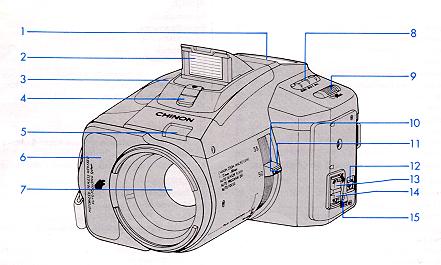
|
1. LCD indication
2. Retractable Flash
3. Shutter release button
4. Main switch
5. Self-time indication LED
6. Auto focus window
7. Lens
|
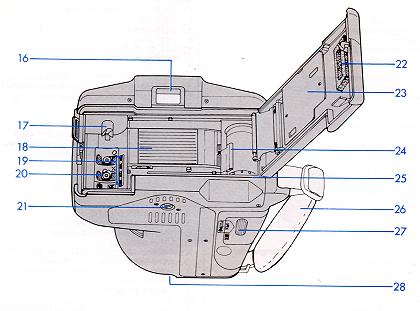
|
8. BLC (Back Light Control) button/Multiple exposure button/Self-time
button
9. Single/Continuous button
10. Macro button
11. Zoom lever
12. Back cover release button
13. FILL-FLASH switch
14. OFF-FLASH switch |
|
15. Manual rewind switch
16. Viewfinder eyepiece
17. Film rewind shaft
18. Quick return mirror
19. Automatic film speed setting contacts
20. Film chamber
21. Tripod socket |
22. Film window
23. Film pressure plate
24. Take-up spool
25. Film tip mark
26. Hand strap
27 Battery compartment cover
28 Tele converter/62 mm filter/lens hood bayonet adapter |
SPECIFICATIONS
Type: motorized fully automatic 35 mm AF lens shutter compact
camera with Single Lens Reflex viewing system with built-in sensor flash and LCD indications.
Type of film: 35 mm film cartridge.
Film format: 24x36 mm
Lens system: CHINON all glass 35-80 mm F/4.1-6.4 lens with Macro,
8 elements in 7 groups.
Macro: Built-in. (Tele macro type)
Viewfinder: Fixed pentaprism type.
Focusing screen: Matte screen with micro prism.
VF Magnification: 0.8x (50 mm at infinity).
VF Coverage: 85% in horizontal and vertical.
Dioptic factor: -1.0 dioptor.
VF indications: Flash symbol LED for flash charging and flash
firing, AF LED for AF OK and near distance warning.
Finder mirror: Motorized quick return mirror.
Auto focusing: Motorized infrared active servo AF system. stepless.
Focus lock: Possible with shutter release button. Cancelable.
AF range: 0.85 m (33 5') -- Infinity (stepless).
Macro range: 0.5 m (19.7~)-0.85 m (33.5~) in manual focusing.
AF mode: Continuous AF for continuous shooting and Single AF
for single shooting mode.
Shutter: Motorized electromagnetic program shutter.
Shutter speed: 1/4 sec.-1/300 sec.
Shutter release: Focus priority shutter release for single frame shooting and action priority shutter release for continuous shooting
mode.
Exposure: Normal program AE and Sew shutter program AE (for Flash
kill or Daylight sync mode).
Metering: TTL average metering
Photocell: S.P.D. .
EV range: (Nominal program) Wide: EV9.5-EV17 (ISO 100)
Tele: EV10.8-EV18.3 (ISO 100). (Slow shutter program)
Wide: EV6-EV17 (ISO 100) Tele: EV7.3-EV18.3 (ISO 100). 1
ISO speed: DX automatic setting for ISO 50,100, 200, 400,1000
and 1600.
Automatic ISO 100 setting Or non-DX films.
BLC: Built-in for +1.5 EV.
Film Loading: Automatically loads film and advances to start
position when the camera back is closed.
Film advance: Automate power winder for single and 3 frame sequences
at approx. 1 fps.
Film rewinding: Motorized fully automatic film rewinding system
with auto rewind start at the
end of the film and auto rewind stop upon
rewind completion. Mid roll rewinding of film is possible.
Film counter: Built-in with LCD panel.
Multiple exposure: Up to three exposure, on 1 frame is possible.
Shooting mode: Single Came shooting mode and cores shooting frame
sequences at approx. of 1 fps.
Flash system: Flashmatic sensor flash system.
Auto recharging: Commences immediately after the flash has been
fired. 3 second recycle time.
Guide No.: 12 (ISO 100)
Flash range (lSO 100): Wide: 0.5-4.0 m (2.8'-13.1') Tele/Macro:
0.5 - 2.7 m (1.6'-8.9')
Daylight sync.: Possible with built-in switch.
Flash override: Possible with built-in switch.
Power source: 6 V lithium battery 2CR5. Built-in with LCD indication. The shutter locks at low battery voltage.
Film type window: Built-in.
Tripod screw: Built-in.
Self-timer: Electronically controlled Self-timer with 10 seconds
delay. Cancelable.
LCD indications: Frame counter/Film transport signal indicator,
Picture taking mode indicator, Self-timer indicator, BLC indicator, Multiple Exposure indicator and
Battery check.
External strobe: Attachable with optional slave unit.
Strap: Hand or neck strap attachable.
Filter: Attachable with filter attachment ring.
Hood: Attachable.
Auto shut off: 30 seconds.
Accessories: 105 mm teleconverter for extreme telephoto use Slave
unit, Dedicated flashes with built-in slave unit, Neck strap lens hood.
Dimension: 121 (L)x87(H)x119(W) mm (4.7x3.4x4.6")
Weight: 745 9 (26 ounces).
A. Battery Installation
1) Insert a pointed object such as a ball-point pen into the battery
cover release hole on the bottom of the camera
and slide it in the direction indicated by the arrow to open the battery
compartment. (Fig. 1 )
2) Place the battery correctly in the battery compartment in accordance
with the marks inside and close the cover.
Use a 6 V lithium battery "2CR-5". (Fig. 2)
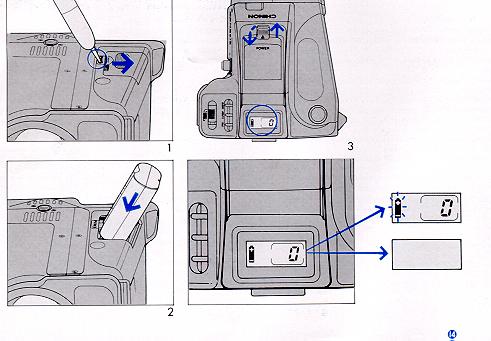
B. Battery Check
Slide the flash-up button (main switch) to the
"ON" position. If the film counter and battery check mark are lighted on
the LCD panel at this time, power is being supplied to the camera circuitry.
The marks will stay lighted for 30 seconds until an automatic power shut-off
system goes into effect. (Fig. 3)
NOTE:
When either of the following occurs, it means that the battery condition
is too low for continued use and should
be replaced with a new one.
--The battery check mark is blinking.
-- Nothing appears on the LCD panel.
* Battery life: Approximately 36 24-exp rolls, using 50% flash (Chinon
laboratory testing)
(Memory Backup System) This camera uses a condenser as a memory
backup. Therefore, even without a battery, the memory function will work
for two to three hours. After that, the film counter will go back to "0"
even in the middle of a roll of film. Replace the battery as quickly as
possible to avoid losing the correct frame number
C. Setting the Film Speed
Films with DX coding. (Fig. 4)
If a film with DX coding is used, the film speed will be set by the
camera automatically Films can be used with ratings
from ISO 50 to 1600.
NOTE:
* For reversal (slide) film, please use ISO 50, 100, 200, 400, 1000
or 1600.
* For film without DX coding, the camera is set automatically at ISO
100. Only use non-DX film with an ISO 100 rating.
* Please keep the camera's DX contact points and the DX information
panels on the film cartridges clean.
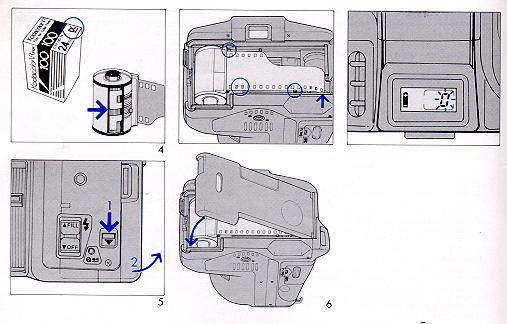
D. Automatic Film Loading
The film should be loaded into the camera carefully, without being subjected
to direct sunlight.
1 ) Open the back cover by pushing the back cover release button in
the direction of the arrow. (Fig. 5)
2) Insert the film cartridge and pull out the film so that the trimmed
end lines up with the film tip mark. Make sure
that the film lies flat between the film guides.
3) Close the back cover. (Fig. 6)
The film will be advanced automatically until the counter on the LCD
panel shows "I".
NOTE:
If the frame counter on the LCD panel is blinking 0 after the back
cover has been closed, it means that the film has not been loaded correctly.
Open up the back cover and insert the film again correctly.
The length of the film should not be too long or too short. If too much
film was pulled out of the film cartridge, then rewind some of it back
into the cassette so
the end of the film reaches the film tip mark on the back of the camera.
When the back cover is opened, do not touch the inside of the mirror
housing.
E. Holding the Camera
Hold the camera in such a way that your elbow is touching your body
securely to ensure camera steadiness and to avoid camera shake. (Fig. 7)
Hold the camera so that fingers, carrying straps, etc. will not cover
any part of the flash unit, lens, or the AF measuring windows.
Press down the shutter release button gently. When the telephoto lens
is in use, be careful to prevent any camera movement.
F. Viewfinder Information
1 ) AF OK signal. When blinking, this indicator warns that the camera-to-subject
distance is too close for proper focus. The Genesis' shutter cannot be
released in the single mode if this condition occurs.
2) Flash Ready Signal When the flash is fully charged, the light will
glow steadily. While the flash is recharging, the same light will blink
until the flash recharging is completed.
3) Auto focus Frame/Microprism This area should be pointed directly
at the picture's subject to assure pinpoint focusing accuracy In the macro
mode, the microprism will assist in achieving sharp focus.
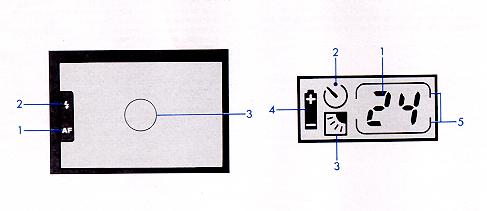
G. LCD Panel Display
1 ) Frame counter
2) Self-timer
3) BLC (backlight control)
4) Battery check
5) Multiple exposure
H. Controlling the Image Size by Using the Zoom
The through-the-lens reflex viewing of the Genesis enables the image
to be viewed exactly as it will result on the picture. Use the zoom lever
to adjust the desired Image size.


|
1 ) Telephotography When a telephoto perspective is desired move the
zoom lever in the direction of the tele (80 mm) position.
2) Wide Angle Photography When a wide angle or panoramic view is required
move the zoom lever in the direction of the wide angle (35 mm) position.
(Fig. 9) |
I. Auto focus Shooting
1 ) Place the AF mode button to the single AF mode position for most
forms of photography. (Fig. 10)
2) Position the camera so that the object is set within the auto focus
frame of the viewfinder (Fig. 11 )
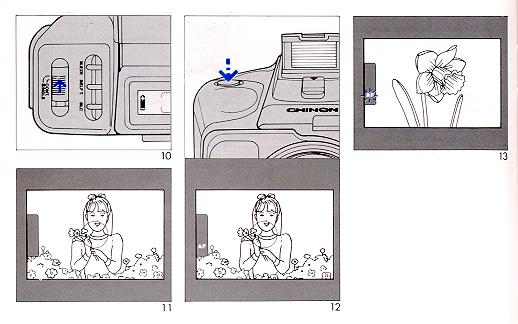
3) Press the release button gently. Focusing is measured and set automatically.
Once the focus has been completed, the "AF OK" mark in the viewfinder will
light up and the object in the auto focus frame will be visible in sharp
detail. This is a visual confirmation that the subject will be correctly
focused on the picture. Press the shutter button all the way to take the
photograph. (Fig. 12) When the camera-to-subject distance is too close,
the AF mark in the viewfinder will blink. The Genesis should then be manually
shifted into the macro mode or the distance between the camera and the
subject must be lengthened. (Accurate AF measurement is from 0.85 meters
(33.5") to infinity. When using the single AF mode, the shutter cannot
be released until the lens has been properly focused. (Fig.13) The following
conditions or subjects may not be properly focused.
NOTE: For proper focusing, make sure that the subject completely
fill the entire area of the viewfinder focusing zone. When focusing on
a subject that cannot fill the entire area of the viewfinder focusing zone,
position the subject at the lower right corner of the focusing zone. This
is the area in which the infrared ray is most precisely controlled. Water
surface, car bodies, glass and similar objects which easily reflect light.
Also, objects viewed through glass windows or wire netting, etc.
J. Automatic Film Rewinding
1 ) When the entire film cassette has been used, the film will automatically
start to rewind within two to three seconds. (Fig. 14)
2) While the film is rewinding the counter will count back wards. When
the film is entirely rewound, the rewind motor will stop automatically
3) Check the frame counter on the LCD panel to make certain that the
film counter shows "0" before opening the back cover
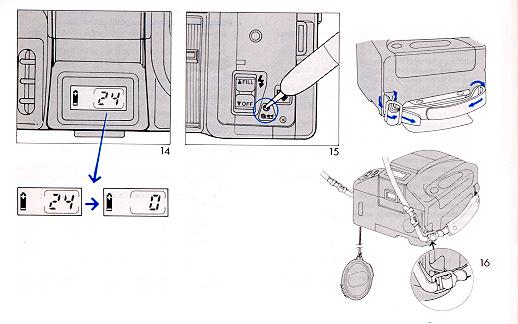
(Rewinding a partially exposed roll of film) If a film must be removed
before it has been completely used, press the manual rewind button located
next to the back cover release button on the side of the camera. Use a
ball-point pen or a similar object which is not too sharp.
Rewinding will begin automatically (Fig. 15)
NOTE:
After the film is rewound, if the frame counter still does not return
to "0", but the frame number is blinking, press the manual rewind button
again.
K. Attaching the Hand Strap and the Lens Cap
The hand strap and the lens cap can be attached to the camera as shown
in the diagram. (Fig. 16)
A. Continuous Shooting
It is possible to take a maximum of three continuous pictures if the
camera is in the continuous AF mode (cons) and
the shutter release is kept fully depressed.
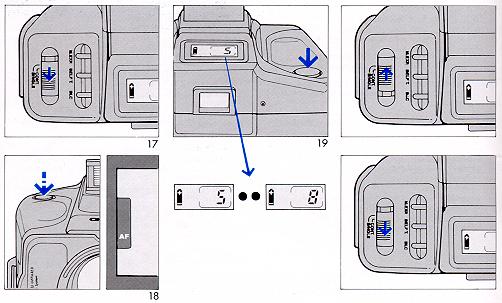
1 ) Set the AF mode button to the Continuous AF Mode (cont). (Fig. 17)
2) Press the shutter release button gently. The automatic focus will
operate and the subject will come into focus.
The AF "OK" signal in the viewfinder will light up. (Fig. 18)
3) After confirming that the AF "OK" signal is lit, take the picture
by pressing the shutter release button all the way down.
4) Keep continued pressure on the shutter release button.
When three frames have been exposed, the camera's film advance will
automatically stop. (Fig. 19)
B. Auto Focus Modes
(1) Single AF Mode(s)
This setting is ideal for general picture taking as it incorporates
a built-in focus lock and subject too close warning. When the shutter release
button is gently pressed, the auto focus system operates and the subject
comes sharply into focus. Sustained pressure on the release button will
maintain a focus lock. In this mode, the shutter will not operate until
the camera has completed the auto focusing procedure.
(2) Continuous AF Mode
This mode allows the camera to continually refocus as the subject moves
closer to or further from the camera.
The shutter can be tripped in this mode regardless whether the subject
is in focus or not.
Pictures may not be in exact focus at times, especially for subjects
that are moving very rapidly
C. AF Lock (Prefocus) and Cancellation
When the main subject is located "off-center" in the view finder, or
when it is difficult to focus on the subject, the focus lock is invaluable.
(Fig. 20)
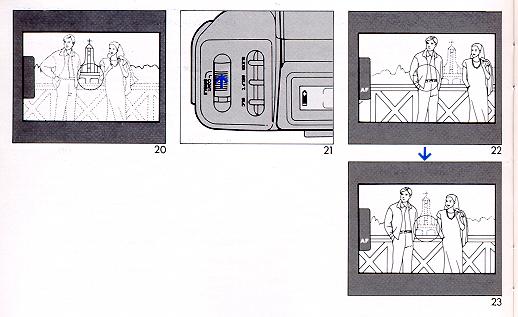
1 ) Set the single/continuous advance switch to the single AF mode.
(Fig. 21 )
2) Look into the viewfinder and point the auto focus frame on the center
of the subject that is to be in focus. Press down gently on the shutter
release and confirm that the AF signal in the viewfinder (green) lights
up. (Fig. 22)
3) Without losing tension on the shutter release button, recompose
the picture in the viewfinder and then take the photograph by pressing
the shutter release button all the way down. (Fig. 23)
NOTE:
The photo lock feature can be canceled by removing your finger from
the shutter release button. Thus, you can repeat this technique a number
of times without having to take a picture.
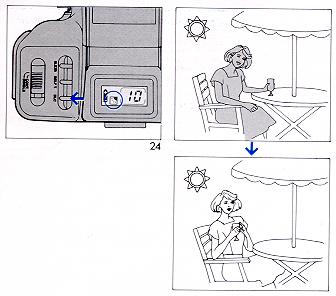
|
D. Exposure Correction (backlight control) When the main subject
has less light falling upon it than the surrounding area, the subject may
be underexposed or silhouetted. The backlight control compensates for the
light imbalance and enables the subject to be more favorably
When the backlight control (BLC) button is pressed, the BLC indicator
will appear in the LCD panel. When the shutter release button is depressed
the exposure will be corrected automatically. (Fig. 24)
|
The exposure correction will be canceled automatically after the picture
has been taken. The backlight compensation can be canceled without
taking
a picture by either pressing the backlight control button again or by closing
the main power switch. When taking a photograph at close distances, it
is recommended that the daylight flash sync function be activated.
E. Macro Photography
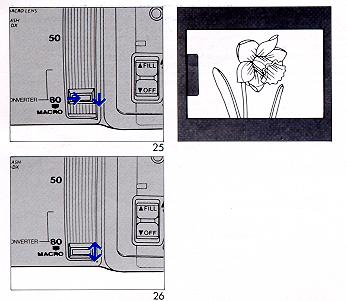
|
Fascinating macro close-ups of subjects can be taken at distances between
50 to 85 cm (19.5" to 33.2').
1 ) Set the zoom lever to the tele (80 mm) position.
After pressing the shift button, rotate the zoom lever to the macro focusing
area. (Fig. 25)
2) The lens must be manually focused. The camera's auto focus
system is inactive when the lens system is shifted into macro.
Ensure that the camera-to-subject distance is within the macro parameter
and then focus by using the zoom lever to achieve sharp focus. (Fig.26) |
3) Press the shutter release button all the way down
to take a picture. Move the position of the camera backward and forward
as needed to assist in focusing the subject. The camera's flash system
operates at a fairly bright level. Some light colored objects may tend
to be overexposed in the case of macro photography. After completing any
desired macro photography, be sure to return the zoom lever to the normal
35-80 mm picture taking position, since the camera's AF system will not
function in macro.
F. Multiple Exposures
By pressing the multiple exposure button, the film will not advance
automatically after taking a picture. Up to three scenes may be photographed
(multiple exposures) on the same frame.

Multiple (Two) Exposures in Single Mode
1 ) Set the Single/Continuous Switch to the SINGLE position. (Fig. 27)
2) Press the multiple exposure button. The LCD's counter frame blinks,
indicating that the multiple exposure mode is activated. (Fig. 28)
3) Take the first photograph by pressing the shutter release button.
The film will not advance at this time.
4) Remove your finger from the shutter release button, and decide on
the composition of the second picture, to be recorded on the same frame
as the first picture. When the second image's composition has been selected,
press the shutter release button to take the second picture. At this point,
the film will advance, the counter frame will stop blinking, and the multiple
exposure mode is automatically canceled.

Multiple Exposures (Three) in Continuous Mode
1 ) Set the Single/Continuous Switch to the CONT. position. (Fig. 29)
2) Press the multiple exposure button. When the counter frame on the
LCD panel starts to blink, the multiple exposure mode is activated. (Fig.
30)
3) After composition has been determined, press and hold the shutter
release button and take the photograph. (Fig. 31 )
NOTE:
* 1. Reversal (slide) film is not recommended for use with the multiple
exposure feature. Prior to developing and printing the film, the photo
finisher should be advised that multiple exposures have been taken. Otherwise,
the negatives may not be printed, or printed improperly. The multiple exposure
technique is suitable for capturing fireworks displays or night scenes,
or when using the flash in a dark area. In daylight, it may result In overexposed
negatives.
* 2. Single and Continuous Multiple Exposure Modes The multiple
exposure mode will remain in effect after the first shot has been taken,
even if the main switch has been set to "OFF". The next picture will be
superimposed on the first picture because the film will have not advanced.
* 3. Continuous Multiple Exposure Mode In this mode, the camera can
also take two shots In rapid succession, followed by a third at some later
time. The multiple exposure mode will be canceled after the third and final
picture has been taken.
G. Self-timer
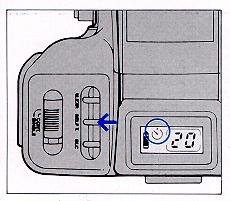
|
The Genesis has a built-in electronic self timer. It enables everyone
to get into the picture and also helps to avoid camera shake in slow shutter
speed situations, provided the camera is placed on a tripod or other firm
surface.
1 ) Compose the picture using the reflex viewfinder.
2) Press the self timer button. The self timer marking will appear
on the LCD display panel as confirmation that the self timer mode has been
activated.
3) Press the shutter release button. The picture will be taken about
ten seconds after the self-timer indication on the front of the camera
lights up. The LED will start blinking about three seconds before the shutter
is released to provide an advance warning of the shutter release. |
(Self-timer Cancellation)
The self-timer can be canceled by pressing the self-timer button again
or by setting the main switch to "OFF". The self-timer will be canceled
automatically if the shutter release is not pushed within 30 seconds of
originally activating the self-timer system. During self-timer operation
the sensor flash will be activated exactly as during normal use. Please
consult the automatic sensor flash mode, off flash mode and fill in flash
mode sections of this booklet for other techniques.
H. Flash Photography
(Automatic Sensor Flash Mode)
The Chinon Genesis is designed to measure ambient light intensity and
then activate and fire the built-in flash when
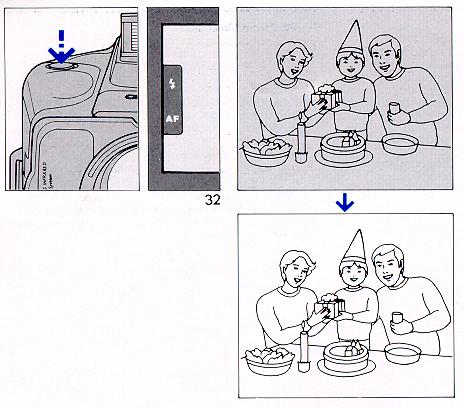
If the "  " mark in the viewfinder lights up or blinks when the release
button is pressed gently, the automatic flash mode is in operation. (Fig.
32)
" mark in the viewfinder lights up or blinks when the release
button is pressed gently, the automatic flash mode is in operation. (Fig.
32)
The "  " flash mark will light when the shutter release is depressed
in the following cases:
" flash mark will light when the shutter release is depressed
in the following cases:
1 ) When the mark glows constantly, the flash is fully charged and the
subsequently exposed picture will be exposed by electronic flash.
2) When it is blinking, the flash is in the midst of charging.
NOTE:
In the single shot mode, the shutter cannot be released. In the continuous
mode, pictures can be taken prior to the flash being fully recycled.
(Effective Flash Distance)
| ISO |
35mm: |
80mm |
| 100 |
0.85~ 4.2 m |
0.5~ 2.7 m |
| 400 |
0.85~ 8.3 m |
0.5~ 5.1 m |
(Off-Flash Mode)
Although the Genesis fires the flash automatically in accordance with
the brightness of the surrounding lighting conditions, there are times
when it might be preferable to take a picture without flash to capture
a special mood. Slide the flash mode switch downward and release the shutter
release button while keeping the switch in that position. The flash unit
will not fire and the resulting image will be exposed with available light
only When this mode is utilized, the flash symbol will not be illuminated
in the viewfinder (Fig. 33)
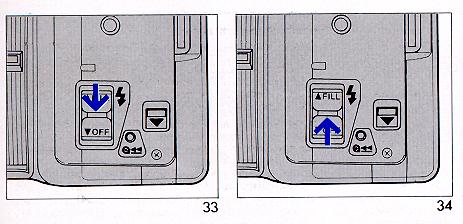
(Fill-in Flash Mode <daylight sync>)
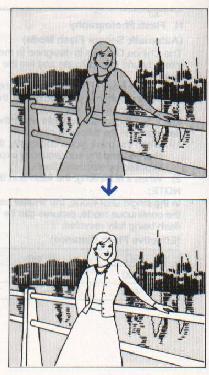
|
Under some available light conditions (deep shade or backlit situations)
a picture may result where the subject is too dark. The use of the flash
for daylight flash fill will enhance the picture tremendously under these
conditions. Fill flash is achieved by sliding and holding the "flash mode
switch" upward and then pressing the shutter release button. The flash
symbol in the viewfinder will light as a confirmation that the daylight
flash system has been activated. (Fig. 34) NOTE: When using flash-off or
fill-in flash, shutter speed may be as slow as 1/4 sec. (Slow Shutter Program),
use of a tripod is recommended in low light situations.
|
I. Filter and Hood
Use the filter ring which is designed specially for the Chinon Genesis
camera. It enables 62 mm filters to be used with the camera. Attach the
filter after the adapter ring has been fitted to the camera. When taking
photographs in backlight ed conditions, use of the lens hood exclusively
designed for this camera is suggested.
The lens hood has two flanges on its circular mounting base. Align these
horizontally with the front of the lens on the Genesis and rotate clockwise
until the hood is firmly seated in place. Remove the flash for flash photography
to assure full frame flash coverage.
NOTE:
When filters such as multi-imaging, etc., are used with the Genesis,
slight vignetting may appear in the corners of the picture.
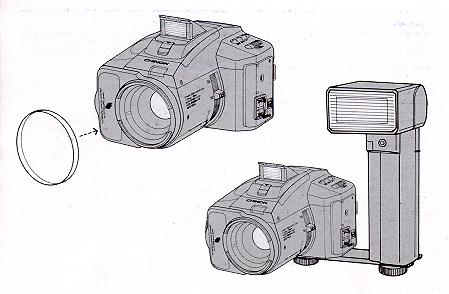
J. External Flash Unit
The external flash unit (Auto GS-320) can be used to extend the effective
flash range of the camera when using ISO 100 or 400 negative films. Using
the Auto GS-320 is recommended when the subject is beyond the effective
flash range of the camera's built-in sensor flash. The Auto GS-320 flash
unit will also permit bounce flash photography.
How to operate:
1 ) Attach the Auto GS-320 to the camera and turn the slave switch on
the flash to "ON".
2) For ISO 100 negative film, select the automatic position of A1 (A2
for ISO 400 negative film). Set the zoom head
of the flash according to the following table and the picture can be
taken.
| Lens focal length |
Flash zoom head position |
| 35 mm |
28 mm position |
| 50 mm |
50 mm position |
| 80 mm |
50 mm position |
| 105 mm (w/Tele Converter) |
105 mm position |
Effective flash range
| ISO 100 negative film |
ISO 400 negative film |
| 35 mm (0.85-7 m, 2.8'-23') (0.85-13 m, 2.8'-43') |
(0.85-13 m, 2.8'-43') |
| 50 mm (0.85-7 m,2.8'-23') |
(0.85-13 m, 2.8'-43') |
| 80 mm (0.85-5 m; 2.8'-16.4') |
(0.85-10 m; 2.8'-33') |
Using the optional slave unit (SE-520)
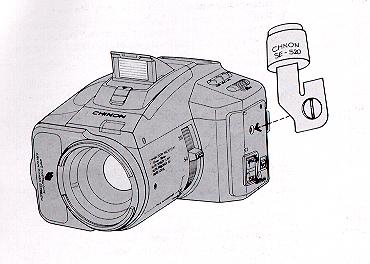
|
With the optional slave unit (SE-520), a hot shoe type automatic flash
unit having an F number setting can be used as an external flash unit with
the Chinon Genesis. The effective flash range can be calculated with the
following formula.
Effective range = Guide number-F
F=4.1 and 6.4 for 35 mm and 80 mm zoom lens settings respectively. |
K. Tele Converter
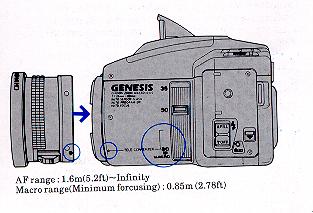
|
Chinon offers an optional tele- converter for the Chinon Genesis which
will extend the focal length of the telephoto distance to 105 mm. For its
operation, the instruction booklet of the tele- converter should be referenced.
|
L. Eyepiece Cover
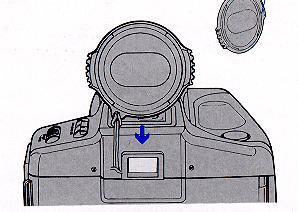
|
The lens cap of the Chinon Genesis is designed to
slope on to the camera's eyepiece. When the self-timer is operated, the
lens cap should be attached to the eyepiece (Fig. 35) to avoid exposure
errors due to stray light entering the camera body. |
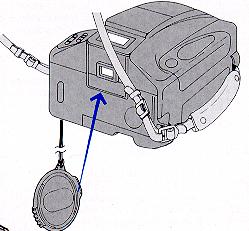
M. Care of the Camera
The Chinon Genesis is a precision photographic
instrument. When used with care it will provide years of trouble free service.
Protect your camera from dirt, rain, dampness and excessive heat. Avoid
touching the lens. To clean the lens, wipe it gently with a soft lintless
cloth or tissue. Do not use eyeglass tissues as they might damage the lens
coating. Do not open and touch the inside of the camera as possible high
voltage in the flash circuitry can be dangerous. When the camera will not
be in use for a long period of time, turn off the main switch and store
in a well ventilated, cool, dry place.
























